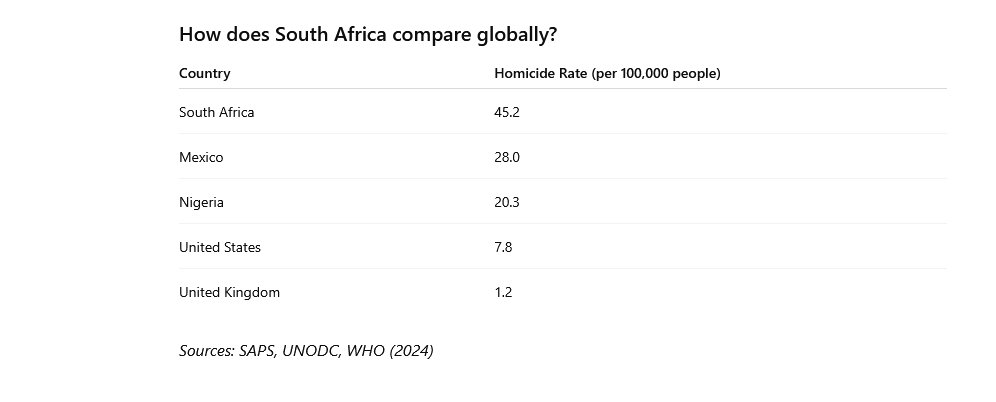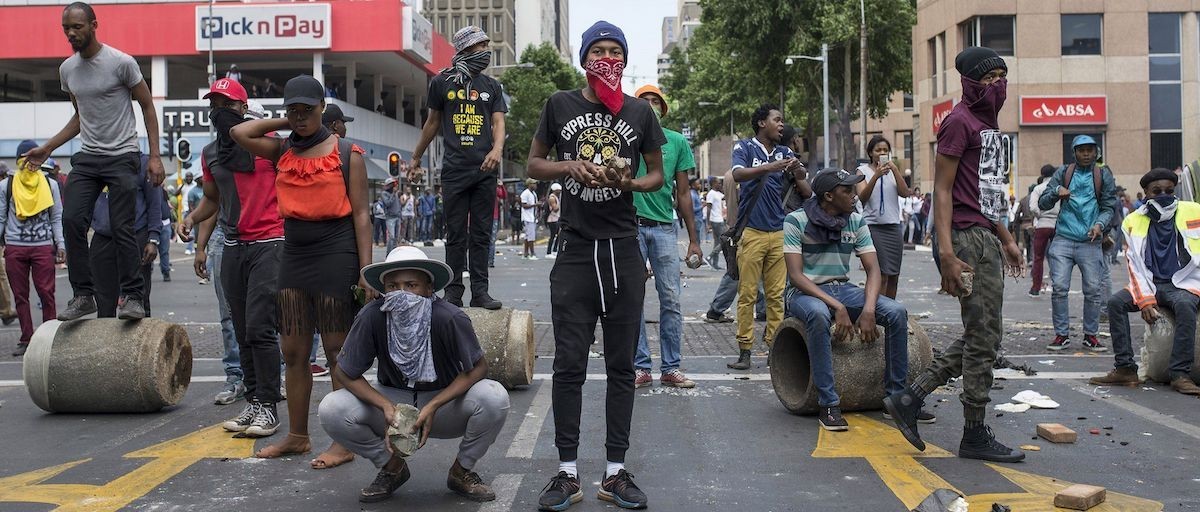Meta Description: Reflecting deep social challenges, South Africa is grappling with one of the highest murder rates in the world. The causes of the crisis are here. Building safer communities begins with understanding the problem.
Violent crime has been exceedingly high in South Africa over the last years. As of now, murder is still the most acute threat to public safety. This menace is widespread; therefore, it affects communities centrally, and this fact has increasingly become a worry not only for the local citizens and the authorities but also for the international community.
With more than 70 murders reported on a daily basis, the country features among the nations with the highest murder scourges in the universe. The discussion provides an analysis of the major factors responsible for this state, the current efforts in the direction of rectifying the situation, and suggestions for reducing violence to create a more tranquil society.
• A total of 27,494 murders occurred between April 2023 and March 2024.
• At a mean of 75 incidences a day.
• The national homicide rate is 45.2 per 100,000 people, significantly above the global average.

Where is violence more common?
The provinces that suffer most are:
• In the Western Cape, incidents are generally linked with organized criminal organizations.
• In KwaZulu-Natal, tensions in communities and conflicts in the locality.
In the Eastern Cape, rural security issues and personal conflicts.
In Gauteng, urban sprawl issues, with the most crime-affected areas.
In Free State and North West, trends that fluctuate generally; however, some specific locales have notable concerns.
“We should treat violence as a public health issue, not just a criminal one,” says Professor Vusi Nkosi, a criminologist at the University of Pretoria.
Who is most affected?
A large percentage of people who die from homicide are of the male gender and 18-35 years old.
In many, instances women are victims of gender-based violence and this occurs within the household.
Children and teenagers are also growingly at risk, either as victims themselves or because of the suffering they experience due to what has happened to the community.
These trends indicate larger social and systemic vulnerabilities that go above criminal activities alone.
Main reasons: why are murder rates so high?
Social and economic inequality
South Africa: One of the most unequal societies in the world. High unemployment, limited access to opportunity and poverty can contribute to social tensions and frustration, increasing the likelihood of violence in some areas.
Challenges in policing and criminal justice: Many police officers are working diligently. Limited resources, high caseloads, and concerns about corruption have un…
• The conviction rate for murder cases stands at approximately 13%, according to ISS Africa.
• Delayed investigations and underreporting have meant that resolution has not come about.
3. Concerns over organized crime and local gangs
Some communities are perpetually pestered by organized crime, significantly escalating violence against individualhood when governance at the local level is weak and there is little social organization.
4. Easy access to guns
There are about 5.8 million guns in circulation, including illegal guns. Key to stopping violence is controlling who has guns. Historical and social factors
The past systemic violence leaves a legacy on social norms, especially in communities with long-term, cyclical violence.
What has been done?
Government and community initiatives:
Operation Shanela – SAPS work to prevent crime in high-risk areas.
Firearms amnesty programs which encourage the voluntary surrender of unlicensed firearms.
Gender-Based Violence Action Plan, a national strategy to reduce violence against women and children.
Projects for youth employment and empowerment that address long-term social factors.
“Safety is not just about policing it is about creating communities where people feel seen heard and supported” Sipho Dlamini KwaZulu-Natal Youth Advocate
Chart Annual trends in homicides in South Africa 2015-2024
Source SAPS ISS Africa
Pathways to safer communities
The scale of the challenge notwithstanding, there steps that can sustainably reduce violence:
✅ Rebuilding community-based policing
• Professionalize law enforcement.
• Increase transparency and accountability.
• Embrace community policing partnerships.
• Addressing root causes
• Expand education, skills development, and economic inclusion.
• Strengthen early childhood and youth programs.
• Access to mental health and trauma recovery services
Gun control and regulation
• Enforce better tracking of licensed firearms.
• Penalize the sale and possession of illegal firearms.
• Collaborate with the civil society to support the process of disarmament.
Outcome
The very high level of South Africa’s homicide reflects a broad set of complex social challenges. This is not just an issue of the administration of justice: this is a human development issue that requires response from all sectors, working long term towards justice and equality and changing lives based on the belief that this is possible.
South Africa can move to a future of safety and dignity for all by investing in people, institutions and communities.
FAQs
1. What is the current murder rate in South Africa?
As of now, South Africa reports about 75 murders a day, with a murder rate of 45.2 per 100,000 people.
2. What provinces have the highest incidence?
Persistent high levels of violent crime are experienced in the Western Cape, KwaZulu-Natal, and the Eastern Cape.
3. The highest risk?
By statistics, young adults are more affected, with men in particular; women face more violence by domestic context.
4. Effective programs available?
Yes, but they will demand more resources, more strong implementation, and more community involved.
5. The place of illegal firearms?
Uncontrolled weapons are one big part and add difficulty to both prevention and law enforcement.
6. What can people do to help keep safety?
Yes. By engaging with the community, supporting local initiatives, and reporting crime or suspicious activity.
7. Is improvement possible?
Yes. Through coordinated policies, community support, and social investment, the cycle of violence can be broken.
